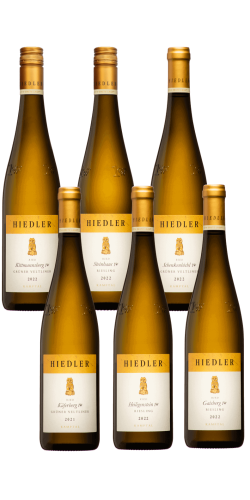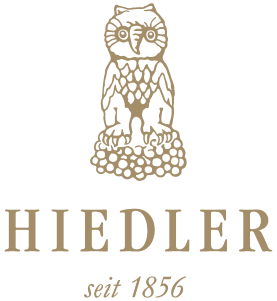https://hiedler.at/en/product/erste-lagen-kollektion/
Erste Lagen Kollektion
In diesen Weinen steckt das Potenzial von historischen, durch ihr Terroir privilegierten Einzellagen (Rieden). Die herausragendsten von ihnen sind als Erste Lage klassifiziert und tragen das Zeichen 1.ÖTW auf dem Etikett und auf der Flasche. Dieses Paket enthält folgende Weine (0,75 lt.):
1 x Grüner Veltliner Ried KITTMANNSBERG 1.ÖTW 2022
1 x Grüner Veltliner Ried SCHENKENBICHL 1.ÖTW 2022
1 x Grüner Veltliner Ried KÄFERBERG 1.ÖTW 2021
1 x Riesling Ried STEINHAUS 1.ÖTW 2022
1 x Riesling Ried GAISBERG 1.ÖTW 2022
1 x Riesling Ried HEILIGENSTEIN 1.ÖTW 2022
1 x Grüner Veltliner Ried KITTMANNSBERG 1.ÖTW 2022
1 x Grüner Veltliner Ried SCHENKENBICHL 1.ÖTW 2022
1 x Grüner Veltliner Ried KÄFERBERG 1.ÖTW 2021
1 x Riesling Ried STEINHAUS 1.ÖTW 2022
1 x Riesling Ried GAISBERG 1.ÖTW 2022
1 x Riesling Ried HEILIGENSTEIN 1.ÖTW 2022
If you are interested to buy this wine, please contact us or our trading partners: Where to buy.


About this package
→ Ried KITTMANNSBERG 1.ÖTW
The Kittmannsberg is located on a distinct high plateau that ascends west of Langenlois, reaching an elevation of up to 365 meters above sea level, thus establishing itself as one of the highest vineyard sites in the Kamptal region. Within its characteristic bowl-shaped topographical depression, it generates a unique microclimate that encourages prolonged ripening periods. The soil possesses a particularly fine mineral structure and consists of calcareous clays and loess-loam, remnants of a former shallow sea. Under these conditions, our Veltliner develops its distinctive attributes, including a yellow fruit expression, subtle herbal spiciness, and a smooth silky texture.
→ Ried SCHENKENBICHL 1.ÖTW
The grapes of this Veltliner come from the highest elevated terraces of the Schenkenbichl vineyard, grown at about 315 m above sea level. Here, our 60-year-old vines are rooted deep in the brittle, metamorphic rock soil, which is formed of the remains of an ancient mountain range. It predominantly consists of dark amphibolite, reaching to the surface. The influence of those rocks is reflected in the wines, which are cool and elegant with a spicy-mineral saltiness to them.
→ Ried KÄFERBERG 1.ÖTW
The Käferberg is certainly one of the best crus that the Kamptal has to offer for Veltliner and Burgundian varieties. Within a small area one can find crystalline rocks alternating with with clayey sea sediments (clay marl) and rare gravels that were deposited in the ancient Paratethys sea millions of years ago and lie directly on the rock of the Bohemian geological formation. Our vines grow at around 345 m above sea level, on two terraces on the south-east flank of the site, where some loess has also been deposited over the past millennia. All of this results in a wine with exceptional density and concentration, whose salty freshness forms an exciting contrast.
→ Ried STEINHAUS 1.ÖTW
Steinhaus, literally Stonehouse, is the steepest vineyard in Langenlois. It probably takes its name from the ancient stone shelters, whose remains can be found scattered in the vineyards. The barren slope is characterized by small terraces, which were partly carved into the crystalline rock centuries ago. The vines have to dig deep to find access to water. They grow on a rocky soil formed of gneiss and amphibolite, traversed by quartz. The location produces a unique, elegantly fruity type of Riesling that expresses a very cool minerality.
→ Ried GAISBERG 1.ÖTW
With its milder microclimate, the exposed Gaisberg is one of the historically most important Riesling vineyards in the Kamptal. A vast variety of metamorphic and crystalline rocks form its soils. On two terraces, our vines dig their roots into Paragneiss. Occasionally there are islands of granite and marble, with shallow covers of loess at the foot of the hill. The concentrated Rieslings of this slope are characterized by their expressive fruit and warm minerality.
→ Ried HEILIGENSTEIN 1.ÖTW
A vineyard that characterizes our Kamptal landscape like no other and is one of the most famed and outstanding crus in Austria. The Heiligenstein is a unique geological formation within Europe; a geological island. The old vines grow on a complex sedimentary soil structure, on sandstone conglomerate with red arkoses and volcanic quartz porphyries. This 280 million year old Permian soil is unique and has remained unchanged through the history of the earth. 60-year-old vines, planted on narrow terraces, yield a highly complex Riesling with a strong personality and a delicately spicy mineral expression.
The Kittmannsberg is located on a distinct high plateau that ascends west of Langenlois, reaching an elevation of up to 365 meters above sea level, thus establishing itself as one of the highest vineyard sites in the Kamptal region. Within its characteristic bowl-shaped topographical depression, it generates a unique microclimate that encourages prolonged ripening periods. The soil possesses a particularly fine mineral structure and consists of calcareous clays and loess-loam, remnants of a former shallow sea. Under these conditions, our Veltliner develops its distinctive attributes, including a yellow fruit expression, subtle herbal spiciness, and a smooth silky texture.
→ Ried SCHENKENBICHL 1.ÖTW
The grapes of this Veltliner come from the highest elevated terraces of the Schenkenbichl vineyard, grown at about 315 m above sea level. Here, our 60-year-old vines are rooted deep in the brittle, metamorphic rock soil, which is formed of the remains of an ancient mountain range. It predominantly consists of dark amphibolite, reaching to the surface. The influence of those rocks is reflected in the wines, which are cool and elegant with a spicy-mineral saltiness to them.
→ Ried KÄFERBERG 1.ÖTW
The Käferberg is certainly one of the best crus that the Kamptal has to offer for Veltliner and Burgundian varieties. Within a small area one can find crystalline rocks alternating with with clayey sea sediments (clay marl) and rare gravels that were deposited in the ancient Paratethys sea millions of years ago and lie directly on the rock of the Bohemian geological formation. Our vines grow at around 345 m above sea level, on two terraces on the south-east flank of the site, where some loess has also been deposited over the past millennia. All of this results in a wine with exceptional density and concentration, whose salty freshness forms an exciting contrast.
→ Ried STEINHAUS 1.ÖTW
Steinhaus, literally Stonehouse, is the steepest vineyard in Langenlois. It probably takes its name from the ancient stone shelters, whose remains can be found scattered in the vineyards. The barren slope is characterized by small terraces, which were partly carved into the crystalline rock centuries ago. The vines have to dig deep to find access to water. They grow on a rocky soil formed of gneiss and amphibolite, traversed by quartz. The location produces a unique, elegantly fruity type of Riesling that expresses a very cool minerality.
→ Ried GAISBERG 1.ÖTW
With its milder microclimate, the exposed Gaisberg is one of the historically most important Riesling vineyards in the Kamptal. A vast variety of metamorphic and crystalline rocks form its soils. On two terraces, our vines dig their roots into Paragneiss. Occasionally there are islands of granite and marble, with shallow covers of loess at the foot of the hill. The concentrated Rieslings of this slope are characterized by their expressive fruit and warm minerality.
→ Ried HEILIGENSTEIN 1.ÖTW
A vineyard that characterizes our Kamptal landscape like no other and is one of the most famed and outstanding crus in Austria. The Heiligenstein is a unique geological formation within Europe; a geological island. The old vines grow on a complex sedimentary soil structure, on sandstone conglomerate with red arkoses and volcanic quartz porphyries. This 280 million year old Permian soil is unique and has remained unchanged through the history of the earth. 60-year-old vines, planted on narrow terraces, yield a highly complex Riesling with a strong personality and a delicately spicy mineral expression.

